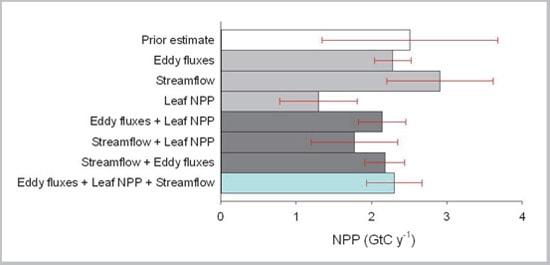As the world progresses towards a global economy that takes account of carbon, there is an obvious need to improve our understanding of the rates at which carbon is stored and released across the Australian continent. Datasets provided through TERN are already being used to improve estimates of Australia’s annual terrestrial carbon budget.
One person at the forefront of work in this area is Dr Vanessa Haverd of CSIRO’s Continental Biogeochemical Cycle team. Her research has measurably increased the accuracy of the model that’s used in regional and global climate modelling.
‘TERN facilities provide access to comprehensive, high-quality datasets that are necessary to improve estimates of carbon fluxes across the continent,’ Vanessa says.
Net primary productivity (NPP) – the difference between carbon that is taken up by vegetation from the atmosphere, and carbon respired by plants – is a critical component in any attempt to generate a budget of carbon released and sequestered on the Australian continent. CABLE, the Community Atmosphere-Biosphere-Land Exchange model, can be used to estimate carbon, water and energy exchanges over set periods and, ultimately, the amount of vegetation growth and mortality, both above and below the ground.
Thanks to the incorporation of real measurements of ecosystem processes, which have been made available through TERN, the new research version of CABLE is much more accurate. The datasets used in the new model include remote-sensing products accessible through TERN’s AusCover facility, biomass estimates from field sites in the Australian Supersite Network, and carbon dioxide and energy flux measurements made available through the OzFlux network.
‘These data have provided a really critical set of benchmarks for CABLE for Australia, and they’ve also led to important structural improvements in the model,’ Vanessa says.
By incorporating multiple observation sets into the research version of the CABLE model, Vanessa and her team were able to constrain model outputs more closely to measured values across representative ecosystems. This means the new research version of CABLE now estimates Australia’s carbon budget with more certainty than was previously possible. The figure illustrates the impact of these data streams on the levels of uncertainty associated with modelled estimates of NPP.
The updated Australian terrestrial carbon budget that Vanessa and her team have developed using this new research version of CABLE will be published in a forthcoming edition of the journal Biogeosciences.
They are working with the research community to ensure that their work feeds into the latest versions of CABLE, which will be accessible for wider use. They will also use TERN’s data infrastructure to make their model output available, and ultimately hope to make their work available through an interactive website. Presenting and updating the modelling framework in an online environment is dependent on the availability of up-to-date data streams, such as remote-sensing data sets available through the AusCover data infrastructure.
Vanessa will present this work at the TERN symposium in Canberra in February, alongside a wealth of other presenters who will demonstrate the breadth of Australian ecosystem science supported by TERN. The full program is on the TERN website.
This work was funded through the Australian Climate Change Science Program (ACCSP). For more information please email Dr Vanessa Haverd.
Published in TERN e-Newsletter January 2013

The reduction in uncertainty is made possible by the inclusion of multiple observation sets to the model. While uncertainty in the prior model estimate, without use of the additional field data types (top bar) was 1.2GtC y-1 (gigatonnes of carbon per year), when three observation types are included (bottom bar) from OzFlux and other sources, the uncertainty is reduced to 0.4 GtC y-1. (Source: Haverd et al., 2012)






